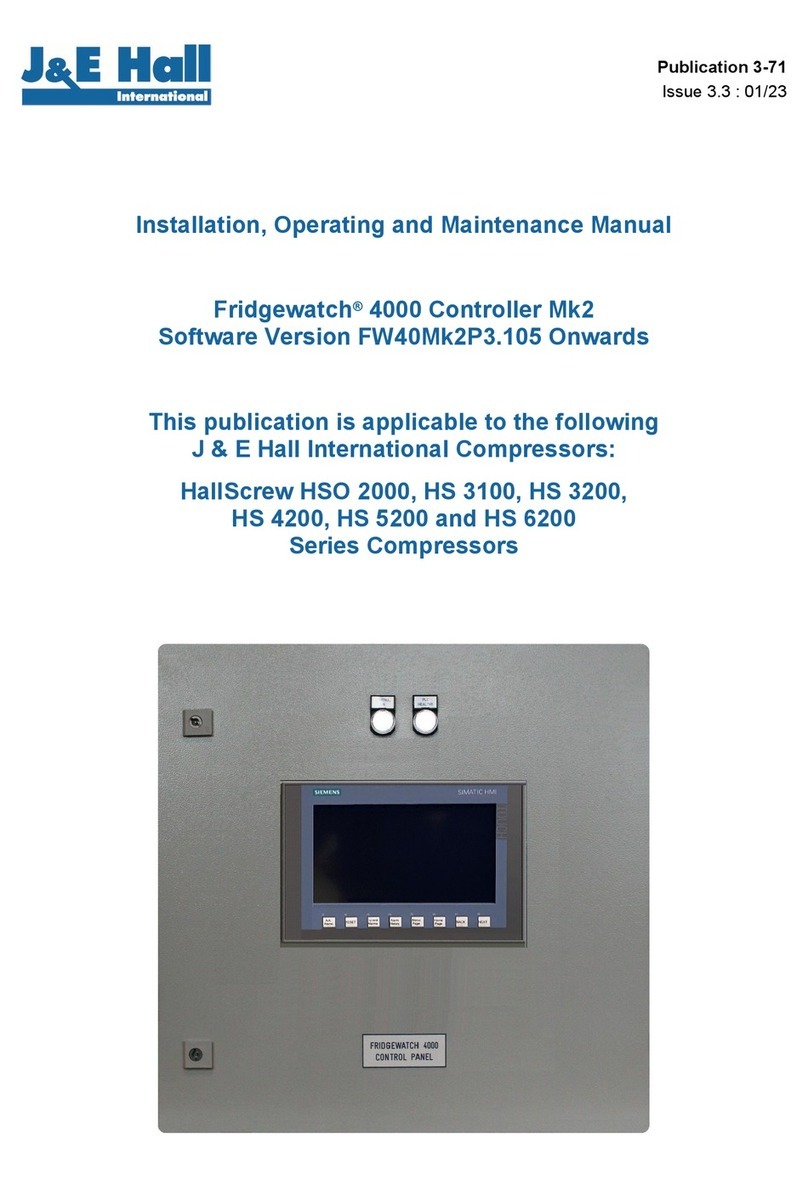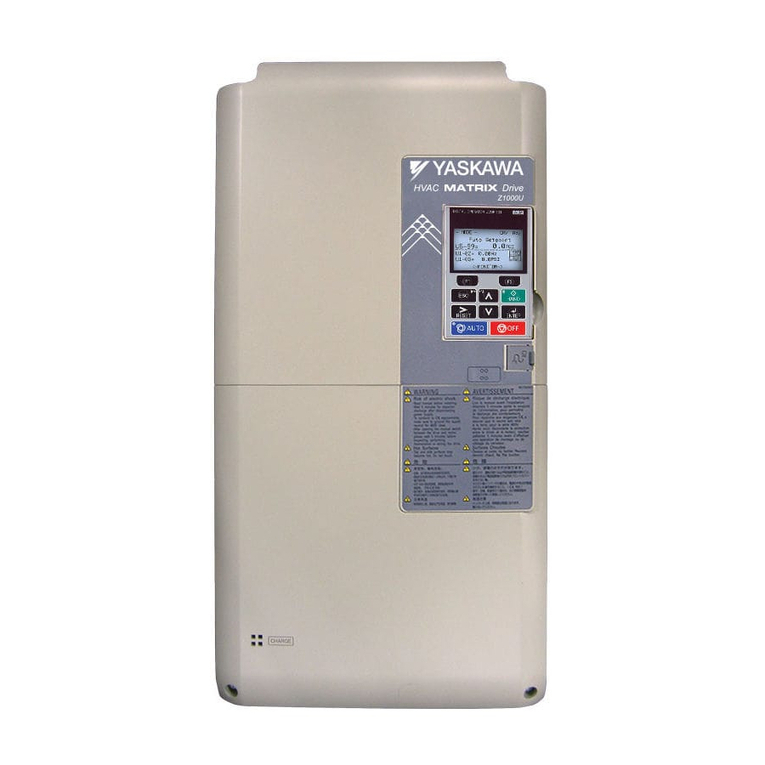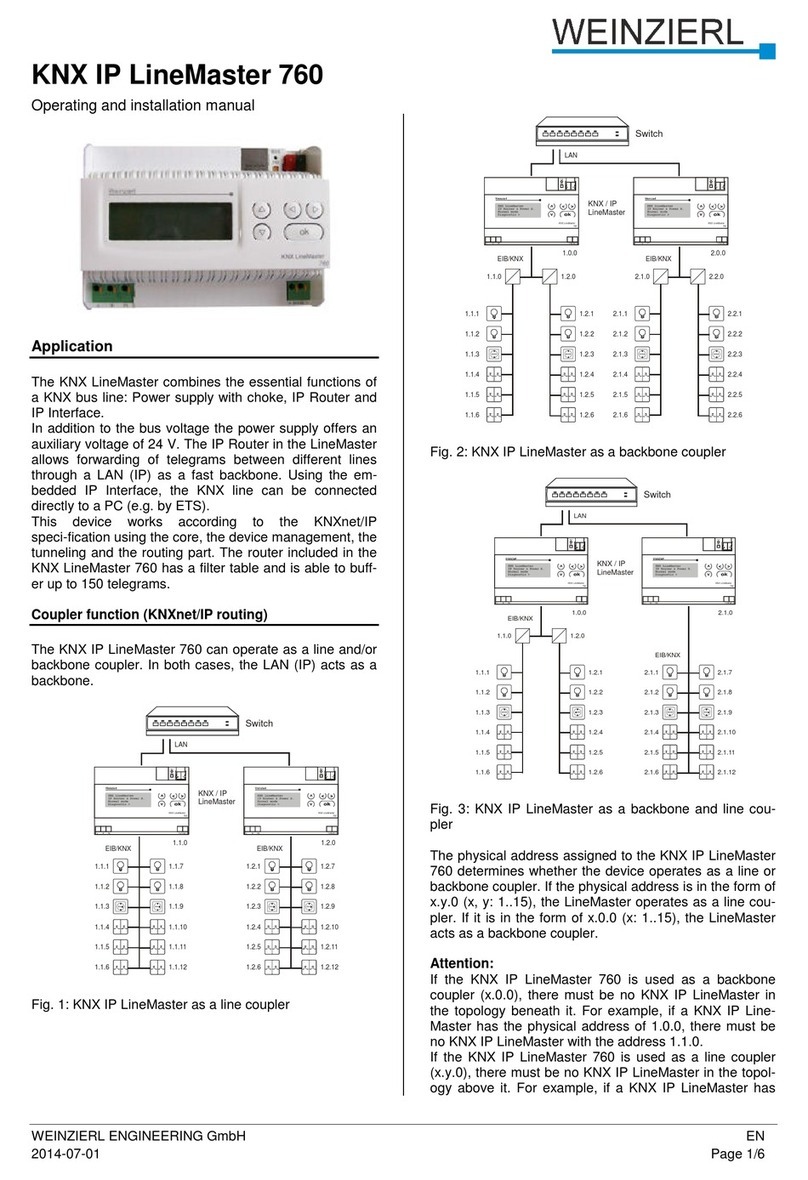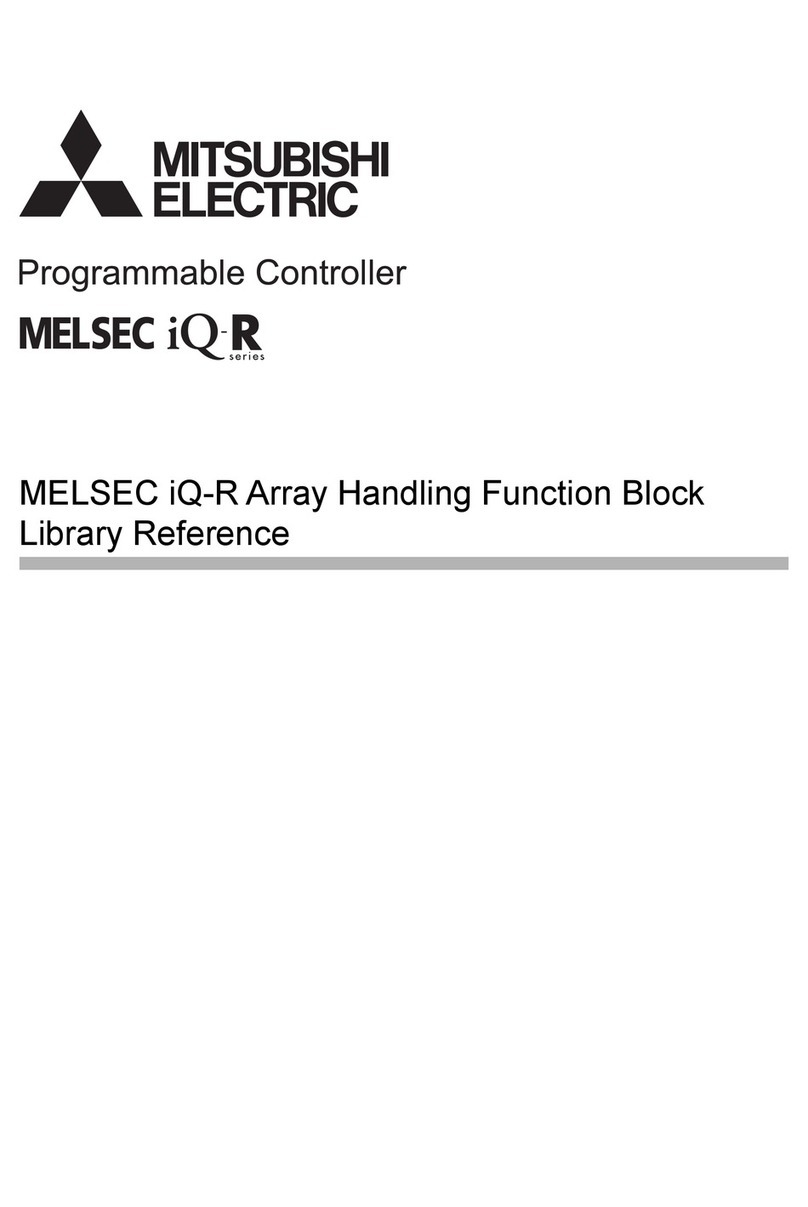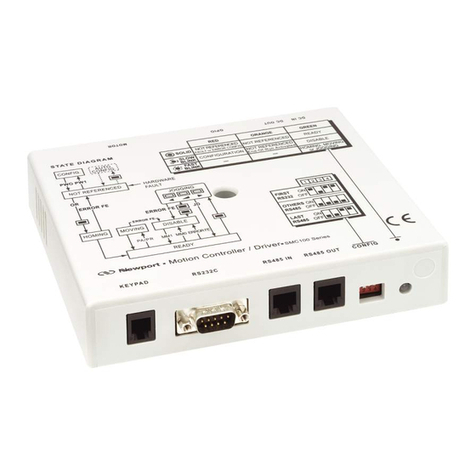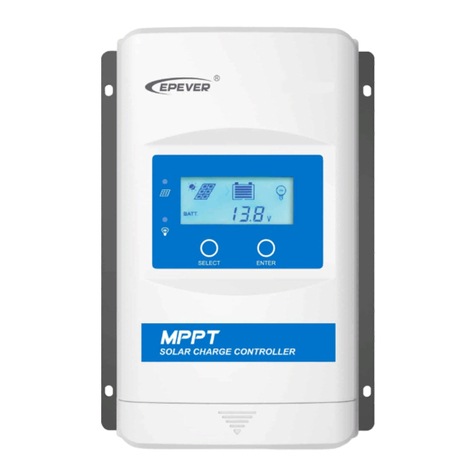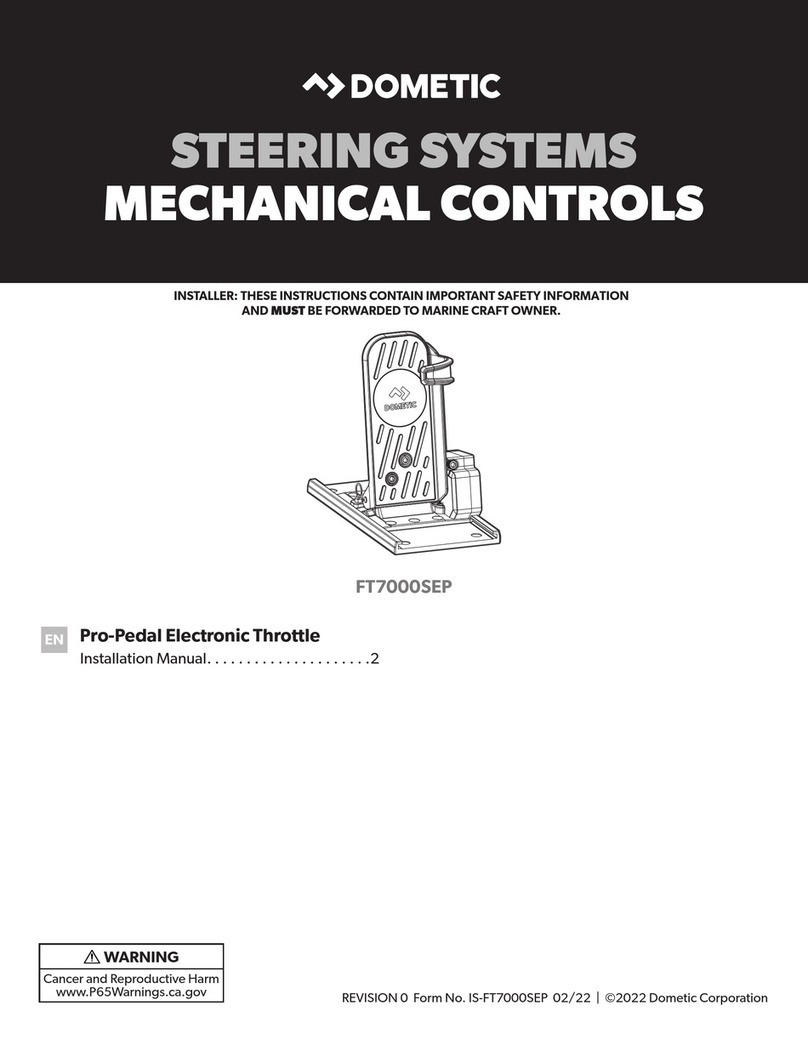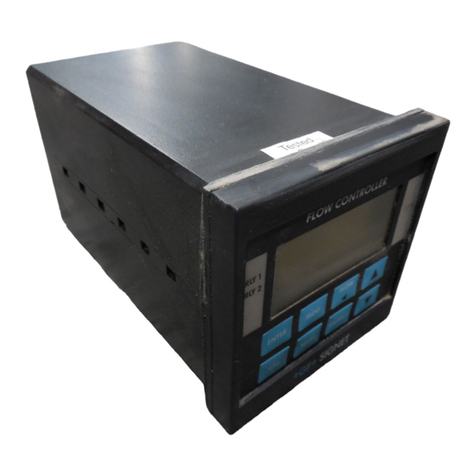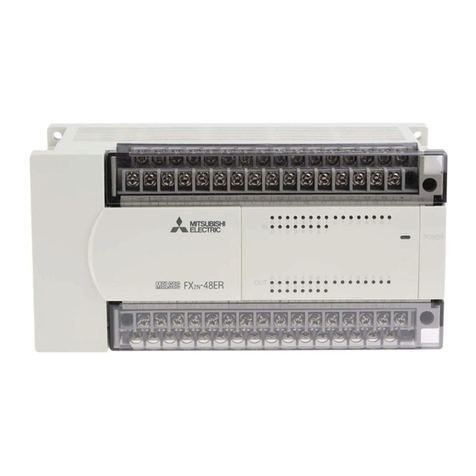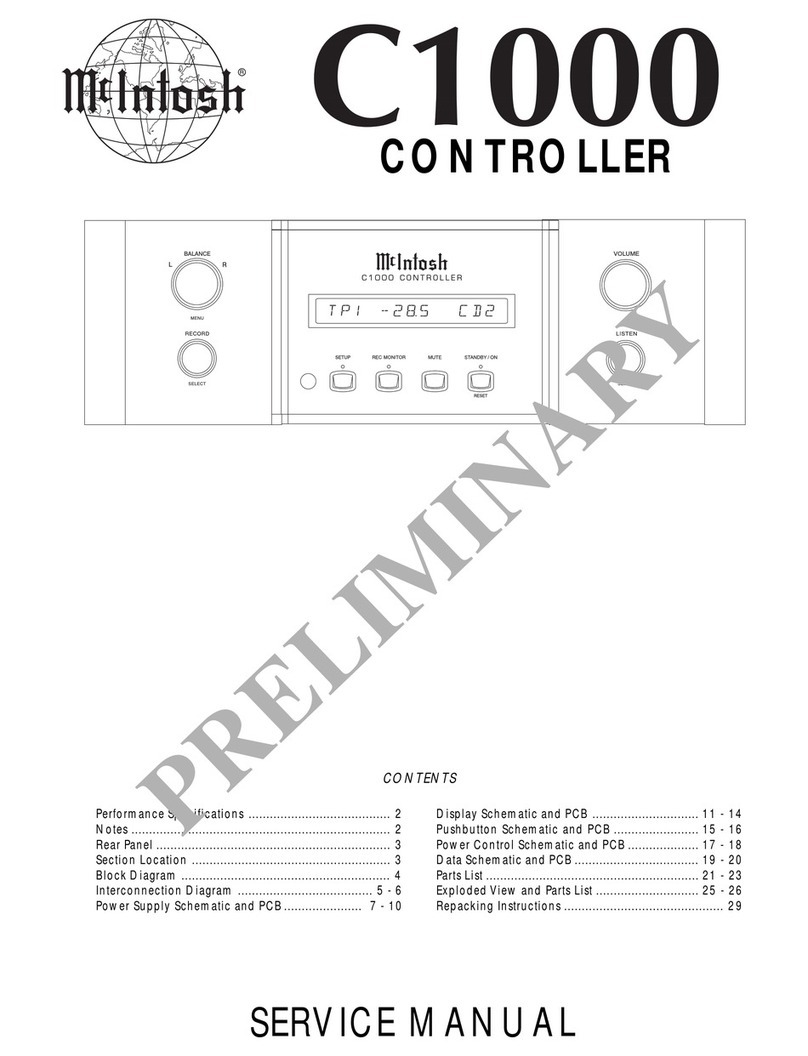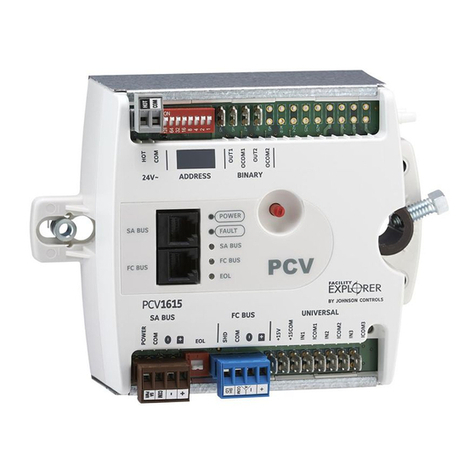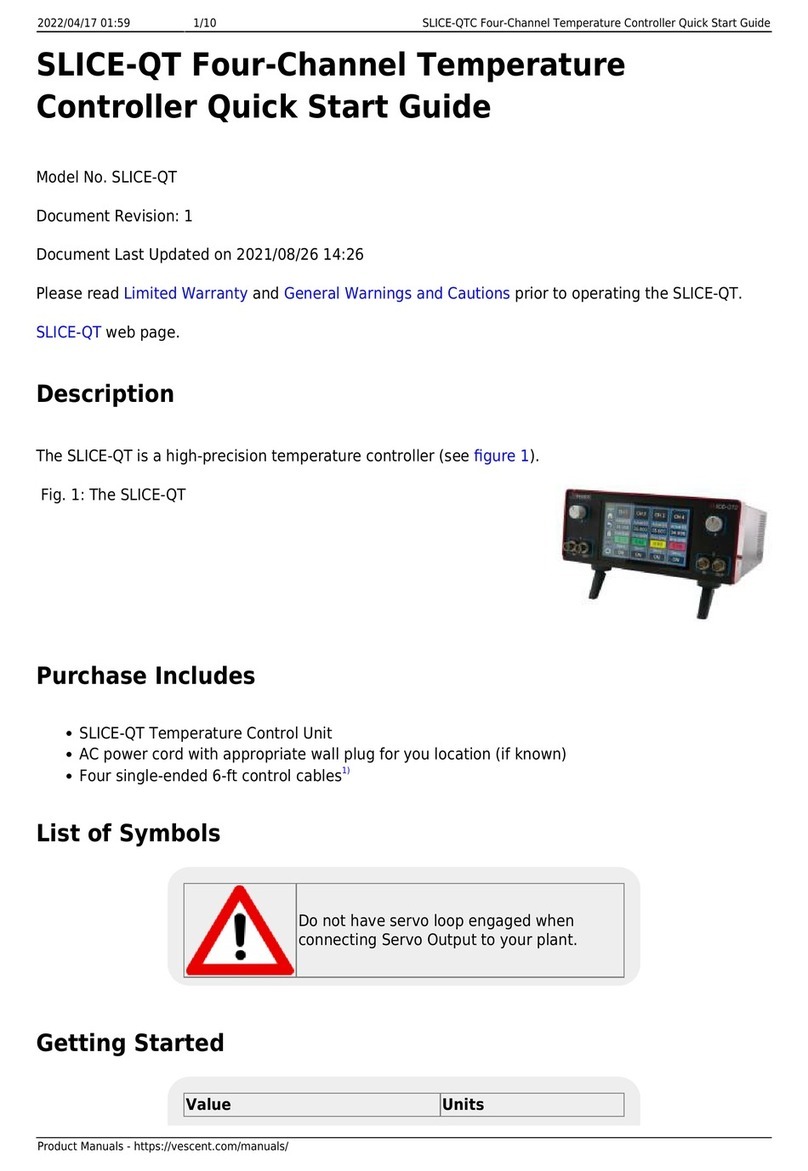J&E Hall Fridgewatch 2100 Installation guide

Publication 3-58
Issue 1.1 : 01/08
Installation, Operating and Maintenance Manual
Fridgewatch®2100 Controller Mk4
This publication is applicable to the following J & E Hall
International Compressors and Packages:
HallScrew 2000 Series Compressors: HS 2018 - HS 2024
HallScrew 2100 Series Compressors
HallScrew 3100 and 3200 Series Compressors
HallScrew 4200 Series Compressors

Fridgewatch 2100 Controller Mk4
Publication 3-58 Section 3
Page 2 of 152 Issue 1.1 : 01/08
J & E Hall International©2008
All rights reserved. No part of this publication may be reproduced or transmitted in any form or by
any means, electronic or mechanical, including photocopying, recording or by any information
storage or retrieval system, without permission in writing from the copyright holder.
The copyright in this publication shall be and remain the sole property of J & E Hall International.
®FRIDGEWATCH is a registered trade name of J & E Hall International.

Fridgewatch 2100 Controller Mk4
Section 3 Publication 3-58
Issue 1.1 : 01/08 Page 3 of 152
Safety
Electrical wiring must be sized and installed to such a standard as to
meet the requirements of the national or local codes pertaining to the
area in which the installation is taking place.
The electrical power used in this equipment is at a voltage high enough to
endanger life. Before undertaking maintenance or repair procedures on
electrical equipment, personnel must isolate equipment from the electrical
supply and test to verify that isolation is complete. Precautions must be
taken to prevent circuits being inadvertently energised, for example,
withdraw the mains fuses, or, if this is not practicable, disconnect the
equipment from the supply before work commences.
If the supply cannot be disconnected or must remain connected to permit
functional testing, fault diagnosis and repair should only be undertaken by
persons who are aware of the hazard and who have taken adequate
precautions to avoid direct contact with dangerous voltages.
If electrical equipment overheats or a fault occurs, it must be
disconnected from the supply and allowed to cool. Overheating may
damage the insulation system, cables, mouldings, gaskets and seals.
The materials used in these components may contain complex organic
compounds which, when degraded by heat or electrical action, produce
chemical compounds in gaseous, liquid or solid forms. Many of these
gaseous and liquid product compounds are highly flammable and toxic.
If it is necessary to extinguish a fire in electrical equipment, follow the
advice given in the Fire Precautions Act 1971, ‘Guide to Fire Precautions
in Existing Places of Work that require a Fire Certificate’ available from
HMSO. Do not approach the equipment until the fire has been
extinguished and the equipment is cool.

Fridgewatch 2100 Controller Mk4
Publication 3-58 Section 3
Page 4 of 152 Issue 1.1 : 01/08
Contents
Safety ........................................................................................................................................... 3
1. About this Publication................................................................................................9
1.1. Safety Warnings and Symbols............................................................................................... 9
1.2. Units of Measurement ............................................................................................................9
1.3. Terminology............................................................................................................................ 9
1.4. Ordering Extra Copies............................................................................................................ 9
2. Care and Protection of Fridgewatch ........................................................................10
2.1. Anti-Static Precautions.........................................................................................................10
2.2. Electrical Interference........................................................................................................... 11
2.3. Prolonged Storage................................................................................................................ 11
3. Personnel Permitted to Install, Commission and Maintain Fridgewatch...................11
4. General Description.................................................................................................12
4.1. Construction.......................................................................................................................... 13
4.2. Technical Data...................................................................................................................... 14
5. Principles of Control.................................................................................................20
5.1. Compressor Capacity Control.............................................................................................. 20
5.1.1. HallScrew 2000 Series Compressors.............................................................................. 20
5.1.2. HallScrew 2100 and 3100 Old Series Compressors....................................................... 20
5.1.3. HallScrew 3100 New Series, 3200 and 4200 Series Compressors ............................... 21
5.2. Proportional, Integral and Derivative (PID) Control ............................................................. 22
5.2.1. Proportional Band............................................................................................................ 22
5.2.2. Integral Action Time......................................................................................................... 24
5.2.3. Derivative Action Time..................................................................................................... 24
5.2.4. PID Control Set-up........................................................................................................... 24
5.3. Basics of Starting and Stopping Compressors.................................................................... 25
5.4. Set Point Deviation............................................................................................................... 25
5.5. Master/Slave Operation........................................................................................................ 26
5.5.1. Starting the Master Compressor...................................................................................... 26
5.5.2. Starting and Stopping the Slave Compressor................................................................. 27
5.5.3. Master/Slave Operation With a Fridgewatch 2100 Controller Controlling
More than One Compressor............................................................................................ 27
5.6. Starting and Stopping the First Compressor........................................................................ 27
5.7. Compressor Running Order................................................................................................. 28
5.8. Capacity Control by Fridgewatch 2100................................................................................ 30
5.8.1. Auto Capacity Control...................................................................................................... 30
5.8.2. Manual Capacity Control ................................................................................................. 30
5.8.3. Remote Capacity Control................................................................................................. 30
5.9. Limiting Inputs ...................................................................................................................... 31
5.9.1. Control Strategy for Limiting Inputs................................................................................. 32
5.9.2. Current Limiting................................................................................................................32
5.10. Limiting on P4 Input.............................................................................................................. 32
6. Installation ...............................................................................................................35
6.1. Analogue Inputs for Sensing Start, Stop and Set Point Values........................................... 35
6.1.1. Using Two Start, Stop and Set Point Values................................................................... 35
6.1.2. Digital Outputs .................................................................................................................36
6.2. Installing Transducers ..........................................................................................................36
6.3. Using Fridgewatch 2100 to Drive Relays............................................................................. 36
6.4. Power Supply Connections (Lower Half of Enclosure)........................................................ 38
6.4.1. Panel Heater....................................................................................................................38
6.5. Wiring Connections to dc Circuits (Upper Half of Enclosure).............................................. 38
6.5.1. Opto-Electronic Liquid Sensor Interface Unit.................................................................. 39
6.5.2. Connections to Economiser Solenoid Valves ................................................................. 39

Fridgewatch 2100 Controller Mk4
Section 3 Publication 3-58
Issue 1.1 : 01/08 Page 5 of 152
6.5.3. Wiring Connections to Electronic Cards.......................................................................... 39
6.5.4. Jumper Connections on Electronic Cards....................................................................... 39
6.6. Fridgewatch Highway Connections...................................................................................... 41
6.7. Summary of Master/Slave Connections............................................................................... 42
7. Cards and Wiring Connections................................................................................45
7.1. FCPS1 Power Supply Card.................................................................................................. 45
7.2. 3SCOP1 Relay Outputs Card .............................................................................................. 46
8. User Interface..........................................................................................................62
8.1. Home Page........................................................................................................................... 62
8.1.1. Event Codes .................................................................................................................... 62
8.2. Contents ............................................................................................................................... 64
8.3. Measured Points................................................................................................................... 64
8.4. Operator Settings and Configuration Settings ..................................................................... 64
8.5. Mode Selection..................................................................................................................... 64
8.6. Information............................................................................................................................ 64
8.7. Status Indicators................................................................................................................... 65
8.7.1. Micro Ok........................................................................................................................... 65
8.7.2. Trip................................................................................................................................... 65
8.8. Operator Input Buttons......................................................................................................... 65
8.8.1. Acknowledge.................................................................................................................... 65
8.8.2. Configuration Settings ..................................................................................................... 66
8.8.3. Home Page...................................................................................................................... 66
8.8.4. Previous Menu................................................................................................................. 66
8.8.5. Stop Compressor(s) (All Modes)..................................................................................... 66
8.8.6. Enter................................................................................................................................. 66
8.8.7. Scroll Up - Raise Setting - Start/Load Compressor (Manual Control Only).................... 67
8.8.8. Lower Setting – Unload Compressor (Manual Control Only).......................................... 68
8.9. Supervisor Keyswitch........................................................................................................... 68
9. Commissioning........................................................................................................70
9.1. Authority to Use the Supervisor Key.................................................................................... 70
9.2. Checks to be Made Prior to Supplying Power to Fridgewatch 2000................................... 70
9.3. Transducer Calibration and Potentiometer Adjustment....................................................... 71
9.4. Inputting Configuration and Operator Settings During Commissioning,
Operating Mode for the First Start........................................................................................ 71
9.4.1. Inputting Configuration Settings During Commissioning................................................. 71
9.4.2. Inputting Operator Settings During Commissioning........................................................ 74
9.4.3. Operating Mode for the First Start................................................................................... 74
9.5. Changing Operator Settings after Commissioning .............................................................. 74
9.6. Changing Configuration Settings after Commissioning....................................................... 74
9.7. Changing the Operating Mode............................................................................................. 76
9.8. Checking the Software Version Number.............................................................................. 76
9.9. Printing or Downloading the Settings List............................................................................ 77
10. Event Codes............................................................................................................78
10.1. Information Only Events....................................................................................................... 78
10.2. Trip Events............................................................................................................................ 78
10.2.1. Compressor Healthy ‘Off’................................................................................................. 78
10.3. Event Codes Description...................................................................................................... 80
11. Settings ...................................................................................................................87
11.1. Operator Settings S1/S39 .................................................................................................... 87
11.2. Configuration Settings S41/109 ........................................................................................... 98
12. Maintenance..........................................................................................................122
12.1. Calibration of Pressure Transducers.................................................................................. 122
12.2. Calibration of Temperature Transducers........................................................................... 123

Fridgewatch 2100 Controller Mk4
Publication 3-58 Section 3
Page 6 of 152 Issue 1.1 : 01/08
12.3. Calibration of Motor Current............................................................................................... 124
12.4. Calibration of LVDT 4 to 20 mA Signal - HS 2000 Series Compressors........................... 125
12.5. Calibration of LVDT 4 to 20 mA Signal – HS 3100 New Series, HS 3200 and
HS 4200 Series Compressors............................................................................................ 125
12.6. Fitting a New RAMP4 Processor Card............................................................................... 125
12.7. Checking and Replacement of Lithium Back-up Battery................................................... 128
12.8. Maintenance Check List..................................................................................................... 128
13. Spares...................................................................................................................129
13.1. Fuses for Mains Input......................................................................................................... 129
13.2. Fuse for Panel Anti-condensation Heater (if fitted)................Error! Bookmark not defined.
13.3. Fuses for Power Supply Card FCPS .....................................Error! Bookmark not defined.
13.4. Electronic Cards.....................................................................Error! Bookmark not defined.
13.4.1. Electronic Card Compatibility ........................................................................................ 129
14. Appendix 1 - Measured Points Reference .............................................................130
15. Appendix 2 - Event Codes E1/E47 Quick-Reference.............................................131
16. Appendix 3 - Settings Record................................................................................133
16.1. Compressor Number/Compressor Serial Number Record................................................ 133
17. Appendix 4 - Start-up Timing Diagram...................................................................148
18. Index......................................................................................................................150

Fridgewatch 2100 Controller Mk4
Section 3 Publication 3-58
Issue 1.1 : 01/08 Page 7 of 152
List of Figures
Fig 1 Multiple Compressors With Common or Individual Oil Separator/Reservoirs.............................. 13
Fig 2 Fridgewatch 2100 Mk4 Controller ................................................................................................. 15
Fig 3 Display Details............................................................................................................................... 16
Fig 4 Internal Layout of Fridgewatch 2100 Panel................................................................................... 17
Fig 5 Enclosure Dimensions and Details of Cable Entries..................................................................... 19
Fig 6 Slide Valve Position Switch Approximation of LVDT 4 to 20 mA Signal ...................................... 21
Fig 7 Proportional, Integral and Derivative (PID) Control.......................................................................23
Fig 8 Possible Compressor Start/Stop and Capacity Control Modes.................................................... 29
Fig 9 Limiting Inputs - Examples ............................................................................................................ 34
Fig 10 Transducer Installation ................................................................................................................ 37
Fig 11 Connecting Diodes ...................................................................................................................... 38
Fig 12 Economiser Arrangements: Wiring to Liquid Line Solenoid Valves............................................ 40
Fig 13 Typical Fridgewatch Highway Connections ................................................................................ 41
Fig 14 Wiring Connections for Master/Slave Without External Run Request or Run Enable Signal.... 43
Fig 15 Wiring Connections for Master/Slave With External Run Request or Run Enable Signal......... 44
Fig 16 FCPS1 Power Supply Card and Wiring Connections................................................................. 45
Fig 17 3SCOP1 Relay Outputs Card...................................................................................................... 46
Fig 18 Wiring Connections to 3SCOP1 Relay Outputs Card for Compressor 1.................................... 47
Fig 19 Wiring Connections to 3SCOP1 Relay Outputs Card for Compressors 2 and 3........................ 48
Fig 20 RAMP4 Processor Card .............................................................................................................. 49
Fig 21 ANP8 Display Card + Display...................................................................................................... 50
Fig 22 Wiring Connections to RAMP4 Processor Card ......................................................................... 51
Fig 23 3MIO1 Input/Output Card for Compressor 1............................................................................... 52
Fig 24 Wiring Connections to 3MIO1 Input/Output Card for Compressor 1.......................................... 53
Fig 25 3MIO2 Input/Output Card for Compressors 2 and 3................................................................... 57
Fig 26 Wiring Connections to 3MIO2 Input/Output Card for Compressors 2 and 3.............................. 58
Fig 27 Menu Structure ............................................................................................................................ 63
Fig 28 Looking at or Changing Configuration Settings .......................................................................... 72
Fig 29 Looking at or Changing Operator Settings.................................................................................. 75
Fig 30 Changing the Operating Mode .................................................................................................... 77
Fig 31 Identifying and Clearing Trip Events, Reasons for Normal Stop and Reason for Trip............... 79
Fig 32 Flowchart to Assist in Adjusting Start Value/Set Point/Stop Value Times.................................. 94
Fig 33 Calibration of LVDT 4 to 20 mA Signal – HS 3100 New Series, HS 3200 and HS 4200 Series
Compressors........................................................................................................................... 126
Fig 34 Compressor Start-up Timing Diagram ...................................................................................... 148

Fridgewatch 2100 Controller Mk4
Publication 3-58 Section 3
Page 8 of 152 Issue 1.1 : 01/08
List of Tables
Table 1 Technical Data........................................................................................................................... 14
Table 2 Transducer Inputs...................................................................................................................... 35
Table 3 Rule for Selecting Controlling Parameters for Two Start Value/Set Point/Stop Value Sets .... 36
Table 4 Wiring Connections to Electronic Cards.................................................................................... 39
Table 5 E14 High or Low P6 (Pressure or Temperature) ...................................................................... 83
Table 6 Determining Compressor Running Order Priority..................................................................... 88
Table 7 Run Enable Required in Different Operating Modes - Values for S14..................................... 91
Table 8 Operating Mode Indication Using Setting S19.......................................................................... 92
Table 9 Initial Load Values on Starting................................................................................................... 96
Table 10 Transducer/Transmitter Types and Ranges ........................................................................... 99
Table 11 Swept Volumes of HallScrew Compressors ......................................................................... 101
Table 12 Capacity Control Valve Application and Operation............................................................... 104
Table 13 Slide Valve Position Indication for HallScrew Compressors................................................. 105
Table 14 Slide Valve Position Options - Values For S63..................................................................... 106
Table 15 Values for S75 to S80 Current Date and Time ..................................................................... 109
Table 16 Maintenance Check List........................................................................................................ 128
Table 17 Fuses ..................................................................................................................................... 129
Table 18 Electronic Cards .................................................................................................................... 129
Table 19 Measured Points Quick-Reference ....................................................................................... 130
Table 20 Measured Points Function and Settings Cross-Reference................................................... 130
Table 21 Compressor Number/Compressor Serial Number Record................................................... 133

Fridgewatch 2100 Controller Mk4
Section 3 Publication 3-58
Issue 1.1 : 01/08 Page 9 of 152
1. About this Publication
These instructions have been prepared according to the following
standards:
BS 4884 : Technical Manuals:
Part 1 : 1992 Specification for Presentation of Essential
Information.
Part 2 : 1993 Guide to Content.
Part 3 : 1993 Guide to Presentation.
BS 4899 : User’s Requirements for Technical Manuals:
Part 1 : 1991 Content.
Part 2 : 1992 Presentation.
BS 4899 is based on the principles of BS 4884.
BS 5378 : Part 2 : 1982 Safety Signs.
1.1. Safety Warnings and Symbols
The system of safety warnings and symbols is based on BS 5378 :
Part 2 : 1982 Safety Signs and BS 4884 : Technical Manuals : Part 1 :
1992 Specification for Presentation of Essential Information.
WARNING
This denotes an immediate hazard with a high likelihood
of personal injury or death if instructions, including
recommended precautions, are not followed. There is
also a potential risk of damage to the product, process
or its surroundings.
CAUTION
This draws attention to instructions which must be
complied with to avoid damage to the product, process
or its surroundings.
NOTE: draws attention to important additional
information.
1.2. Units of Measurement
Quantities are expressed in SI units or SI derived units.
1.3. Terminology
Terminology, abbreviations and acronyms are those currently in use
throughout the refrigeration and air conditioning industry.
1.4. Ordering Extra Copies
Obtain extra copies of these instructions from the address below:
J & E Hall International Telephone: +44 (0) 1634-731-400
Engineering & Projects, Fax: +44 (0) 1634-731-401
Sir Thomas Longley Road, Website: www.jehall.co.uk
Medway City Estate,
Rochester,
Kent ME2 4DP
England

Fridgewatch 2100 Controller Mk4
Publication 3-58 Section 3
Page 10 of 152 Issue 1.1 : 01/08
2. Care and Protection of Fridgewatch
CAUTION
If welding is to be carried out in the vicinity of the
Fridgewatch Controller or any other items of plant
containing semi-conductor devices, for example,
transistors and microprocessors, the welding
equipment must be adequately earthed adjacent to the
point of weld. The Fridgewatch Controller or other
electronic devices must not be positioned between the
site where the welding is taking place and the point of
earth, or irrevocable damage may be caused to the
electronics, with possible consequential damage to the
plant.
2.1. Anti-Static Precautions
The electronic cards fitted to Fridgewatch are electrostatic sensitive.
That is to say, damage to the card or its components can occur as the
result of electrostatic discharge from or through personnel. To protect
electronic cards and components, precautions against electrostatic
hazards must be taken according to BS EN 100015: Part 1: 1991. Note
the following:
•Persons handling electronic cards must be earthed, in
accordance with BS EN 100015: Part 1: 1991, to the earth
terminal on the Fridgewatch Controller or other suitable
earthing point.
WARNING
The earth bonding device, for example, wrist strap and
its application, must conform to BS EN 100015: Part 1:
1991. Failure to use the correct earth bonding device in
the correct manner can result in death or serious injury
if there is accidental contact with hazardous voltages.
•Immediately after removing a card from the Fridgewatch
Controller, place the card in an electrostatic conductive or
dissipative envelope. The card should remain in its envelope
other than when the card is installed or being worked on.
•When working on a card, for example, when replacing the
lithium battery on the RAMP Processor Card, the card must
be placed on an earth bonded electrostatic conductive or
dissipative mat and the person carrying out the work must
bonded to earth as described above.
•Spare cards must be kept in an electrostatic conductive or
dissipative envelope, one card per envelope. Each envelope
should be sealed and stored in a cool, dry place well away
from strong magnetic sources.
•Never remove or replace an electronic card with the
Fridgewatch Controller power supply turned on.

Fridgewatch 2100 Controller Mk4
Section 3 Publication 3-58
Issue 1.1 : 01/08 Page 11 of 152
2.2. Electrical Interference
To avoid problems of electrical interference, all low voltage wiring
(transducers, data communications and 24 V dc) must be adequately
separated from higher voltage ac wiring (110 V, 240 V, 415 V or higher).
A separation of 150 mm is desirable but not always achievable within
control panels. Low voltage and higher voltage cables should cross at
right-angles.
2.3. Prolonged Storage
If the Fridgewatch Controller, or the plant of which it forms a part, is not to
be installed immediately but held in store, observe the following points:
•The Fridgewatch Controller should preferably be stored
indoors, in a well ventilated, clean, warm and dry
environment. If the equipment is stored outside, protection
from the elements must be provided; coverings should be
selected and arranged to reduce the risk of condensation.
•Fridgewatch contains programmed integrated circuits
(memory chips) which are sensitive to low temperatures.
The controller should not be exposed to ambient
temperatures below -10 °C.
3. Personnel Permitted to Install, Commission and Maintain Fridgewatch
It is essential that only authorised and competent personnel are allowed
to install, commission and maintain the Fridgewatch Controller. A permit
to work system should be introduced before commissioning begins, and
should be rigorously enforced thereafter.
Any person rendering assistance or under training must be supervised by
the authorised competent person who has responsibility for safety.
Personnel must be familiar with the plant’s construction, operation and
the hazards involved. All personnel should make a thorough study of
these instructions before undertaking installation, commissioning,
maintenance or repair procedures.

Fridgewatch 2100 Controller Mk4
Publication 3-58 Section 3
Page 12 of 152 Issue 1.1 : 01/08
4. General Description
The Fridgewatch 2100 Mk4 Controller is a compact integrated solution for
the control and management of refrigeration systems based on the J & E
Hall International HallScrew compressor. Fridgewatch replaces the
collection of pressure, temperature and motor current controllers, timers,
relays and programmable logic controllers (PLCs) that might otherwise be
used. To the basic functions: compressor starting and stopping, running
order priority (lead/lag), safety monitoring and capacity control,
Fridgewatch 2100 adds a number of enhancements which permit
compressor operation to be optimised to suit the running conditions.
Other facilities include the ability to communicate with another
Fridgewatch Controller and/or Compressor Management System.
Remote display and permanent logging facilities can be provided by
connecting a VDU and a printer.
1, 2 or 3 compressor versions of the Fridgewatch 2100 Controller are
available, the physical differences being confined to the number of
input/output cards fitted (1 for each compressor). This feature provides
for simple upgrading in the field should additional compressors be added
later and also means that display and operator inputs are common to all
versions for ease of operator familiarisation and use.
Linked to another Fridgewatch 2100 or a Fridgewatch 2000 Controller,
the Fridgewatch 2100 Controller can be run in a master/slave
configuration.
Fridgewatch 2100 monitors the safe operation of the plant and, in the
event of a fault condition, displays where the fault lies. However, fault
detection does not rely on the program running in the microprocessor. In
common with conventional relay based control panels, the signal to stop
the compressor is derived from the electrical contacts of mechanical
pressure and temperature safety devices. Primary pressure and
temperature safety inputs are linked in series so that a fault condition will
automatically remove the run signal to the compressor motor, quite
independent from the microprocessor. Safety inputs and all other digital
inputs are read into Fridgewatch 2100 in the form of 24 V dc signals.
Either cooled medium temperature or suction pressure can be used as
the controlling parameters. Compressor start and stop temperature or
pressure variables, and the set point value for capacity control, are
sensed by transducers from the same point on the plant or from two
different points. These transducers are connected to analogue inputs 1
and 2 mounted on the compressor 1 3MIO1 input/output card.
Compressor motor current, read from a current transformer, can be used
by Fridgewatch 2100 to inhibit compressor loading if current consumption
reaches a predetermined threshold, or to unload if consumption
continues to rise. Similar limiting functions are also available from other
analogue inputs, for example, suction pressure. Limiting is also available
via digital inputs for system specific limiting requirements.
Compressor slide valve position can be read and displayed from the
4 to 20 mA signal from the Linear Variable Displacement Transducer
(LVDT) fitted to HallScrew 2000 series compressors. The minimum,
intermediate and maximum slide valve position switches, part of the
LVDT, and the three reed switches fitted to HallScrew 2100 series
compressors, can be used to initiate an event.
Fridgewatch 2100 can display key system temperatures, pressures and
compressor hours run.

Fridgewatch 2100 Controller Mk4
Section 3 Publication 3-58
Issue 1.1 : 01/08 Page 13 of 152
Fridgewatch 2100
Controller
Fridgewatch 2100 can
control a single
package unit fitted
with one, two or three
HallScrew
compressors using a
common oil separator
or
Fridgewatch 2100 can
control one, two or
three package units
each comprising a
HallScrew compressor
and oil separator
Fridgewatch 2100
Controller
Oil Separator/Reservoir
Oil Separator/Reservoir
Oil Separator/Reservoir
Oil Separator/Reservoir
Fig 1 Multiple Compressors With Common or Individual Oil Separator/Reservoirs
4.1. Construction
The Fridgewatch 2100 Controller enclosure, to IP43 (IP55 available as an
option), is divided into two completely separate sections as illustrated in
Fig 2, Fig 3 and Fig 4. The relay outputs (240 V ac or 110 V ac) required
to drive the various solenoid valves, along with the oil separator/reservoir
heater outputs and power supply connections, are located in the lower
half of the enclosure, completely isolated from the 24 V dc electronics in
the upper half. A door interlocked mains isolator prevents access to the
lower section unless the isolator has been turned to the ‘off’ position.
Common
Discharge
Line

Fridgewatch 2100 Controller Mk4
Publication 3-58 Section 3
Page 14 of 152 Issue 1.1 : 01/08
The display indicators, operator input buttons, Supervisor Keyswitch and
audible alarm are mounted on the door to the upper half of the enclosure.
The main microprocessor logic card, mounted on the back of the door,
contains the program held in flash erasable programmable read-only
memory (FLASH EPROM) for security; data on FLASH EPROM is
impervious to power supply fluctuations or even complete loss of power
for an indefinite period of time. All control settings and stored variables
are held in random access memory (RAM), backed up by a lithium
battery with an expected life of 8 years.
To guard against non-specific microprocessor malfunctions, perhaps as a
result of exceptional power supply fluctuations, the Fridgewatch 2100
Controller incorporates a Watchdog device which continuously monitors
the microprocessor all the time it is running. If the Watchdog detects a
potential fault condition, it automatically resets the microprocessor. After
restarting, Fridgewatch returns to the previous mode of control. If this
was an auto start/stop mode and there is a demand for duty, Fridgewatch
restarts the compressor (subject to normal starting/running parameters).
4.2. Technical Data
Enclosure To IP43 (IP55 available as an option)
Overall dimensions 670 mm high x 360 mm wide x 150 mm deep; refer to Fig 5.
Weight 19 kg
Compressor and
auxiliaries run signals 40 mA maximum at 24 V dc
Back-up battery Style: disc. Nominal volts 3.0 V measured between the
RAMP4 card 0 V tab and the battery face.
Estimated life 8 years. Recommended replacement time
every 5 years or when the voltage drops to 2.7 V.
Relay ouputs 240 V ac or 110 V ac
Relay contact rating 8 A continuous at 250 V ac, 3 A inductive at 250 V ac
Wiring inside panel Use 0.5 mm2cable
1Power supply 110/240 V ac, 50 Hz to 60 Hz. Check the position of the
jumper on the FCPS1 power supply card; refer to Fig 16.
1Power may be taken from a line and neutral supply. If power is derived from a
transformer, the common side of the secondary winding must be earthed. Centre
tapped earthed type transformers MUST NOT be used with the standard Fridgewatch
2100 panel; contact J & E Hall International.
Table 1 Technical Data

Fridgewatch 2100 Controller Mk4
Section 3 Publication 3-58
Issue 1.1 : 01/08 Page 15 of 152
Fig 2 Fridgewatch 2100 Mk4 Controller
Mains
Isolator
1
S
0
Supervisor
Keyswitch

Fridgewatch 2100 Controller Mk4
Publication 3-58 Section 3
Page 16 of 152 Issue 1.1 : 01/08
Enlargement of Fridgewatch 2100 Display
Button Legend Function Ref For Description
☺MICRO OK Extinguishes to indicate a microprocessor fault
TRIP ‘Flashes’ to indicate a trip event.
ACKNOWLEDGE Press to acknowledge trip event.
CONFIGURATION
SETTINGS
Input/change Configuration settings.
HOME PAGE Return to Home page from any menu page.
PREVIOUS MENU Return to previous menu level.
STOP
COMPRESSORS (ALL
MODES)
Stop compressor.
ENTER Select the active menu item.
NAVIGATION
BUTTONS
In manual control mode, start and load/unload the
compressor. Scroll through points and settings lists.
Change Operator and Configuration setting values using
the Supervisor Key.
SUPERVISOR KEY
Key operated switch permits modification of Operator and
Configuration setting values, change operating mode,
accept/enter selections and with ‘manual’ start/stop –
‘manual’ capacity control mode selected, allows the
compressor to be loaded and unloaded manually by the
operator.
Fig 3 Display Details

Fridgewatch 2100 Controller Mk4
Section 3 Publication 3-58
Issue 1.1 : 01/08 Page 17 of 152
Fig 4 Internal Layout of Fridgewatch 2100 Panel
3SCOP1 Cards;
refer to Fig 17
Earth Connecting Block
FCPS1 Card;
refer to Fig 16
MCB
Mains
Isolator
Thermistor/Optor Sensor
Conditioning Unit(s)
Mounting
Board
3MIO1 Card for
Comp 1: refer
to Fig 23 3MIO2 Card for Comp 2: refer to Fig 25
Comp 1 Comp 2

Fridgewatch 2100 Controller Mk4
Publication 3-58 Section 3
Page 18 of 152 Issue 1.1 : 01/08
Fig 4 (continued) Internal Layout of Fridgewatch 2100 Panel - Door Mounted Items
Door to Lower Half of Enclosure
Door to Upper Half of Enclosure
RAMP4 Processor Card; refer to Fig 20
ANP8 Display Card; refer to Fig 21
Cover,
mounted on
stand-offs,
removed to
show ANP8
and RAMP4
cards.

Fridgewatch 2100 Controller Mk4
Section 3 Publication 3-58
Issue 1.1 : 01/08 Page 19 of 152
Fig 5 Enclosure Dimensions and Details of Cable Entries
360 mm
390 mm
420 mm
Gland Plate
(335 mm x 110 mm)
40 mm
Gland Plate
(230 mm x 110 mm)
Mounting Hole
8 mm Diameter
5 mm
150 mm
187 mm
35
mm
1 Hole 20 mm Diameter
(Incoming 240 V/110 V ac Supply) Third Angle Projection
Not to Scale
Dimensions in mm
600 mm 670 mm
65 mm
35 mm

Fridgewatch 2100 Controller Mk4
Publication 3-58 Section 3
Page 20 of 152 Issue 1.1 : 01/08
5. Principles of Control
The primary requirement of any refrigeration control system is to match
the measured variable (temperature or pressure) as closely as possible
to the desired control value (set point), while at the same time optimising
the use of available compressor capacity.
In this part of the manual we will look first at the basic capacity control
system fitted to HallScrew compressors, then examine the fundamentals
of proportional, integral and derivative control before going on to describe
how Fridgewatch 2100 starts and stops the compressor in single
compressor and master/slave applications. Having grasped the
underlying principles, it is possible to make a reappraisal of the control
system as a whole, and more readily understand the enhancements
possible to the basic control elements by using Fridgewatch 2100.
5.1. Compressor Capacity Control
The capacity control system, common to all HallScrew compressors,
permits compressor capacity to be altered to match loading conditions as
closely as possible.
5.1.1. HallScrew 2000 Series Compressors
The compressor capacity control slide valves modulate capacity between
minimum and maximum (10 % and 100 % of full load). Oil pressure,
generated by the system suction/discharge pressure differential, moves
the capacity control piston attached to one end of the slide valves to load
or unload the compressor. Solenoid valves in the pipe lines supplying
and venting oil to either side of the capacity control piston are energised
(opened) or de-energised (closed) by Fridgewatch 2100 for a timed
period.
Three different methods of slide valve position indication have been fitted
to HallScrew HS 18 to HS 235 and 2000 series compressors; refer to
Table 13 and the descriptions in the HallScrew 2000 compressor
instruction manual, publication 2-49.
The LVDT and NLVDT is provided with three slide valve position
switches: minimum load (10 %), intermediate load (user defined) and
maximum load (100 %). The compressor loading range is divided into
four discrete bands as illustrated in Fig 6.
5.1.2. HallScrew 2100 and 3100 Old Series Compressors
The compressor capacity control slide valve modulates capacity between
minimum and maximum (25 % and 100 % of full load). Oil pressure,
generated by the system suction/discharge pressure differential, moves
the capacity control piston attached to one end of the slide valve in the
load direction, while a compressed spring on the unload side of the piston
moves the piston in the unload direction when the oil pressure is
released. Solenoid valves in the pipe lines supplying and venting oil to
either side of the capacity slide valve piston are energised or de-
energised (opened or closed) by Fridgewatch 2100 for a timed period.
HallScrew 2100 and 3100 old series compressors are not fitted with an
LVDT to supply a 4 to 20 mA signal; three slide valve position reed
switches are provided, one for minimum load (25 %), one for intermediate
load (50 %) and one for maximum (100 %) load. The loading bands are
illustrated in Fig 6.
Table of contents
Other J&E Hall Controllers manuals

